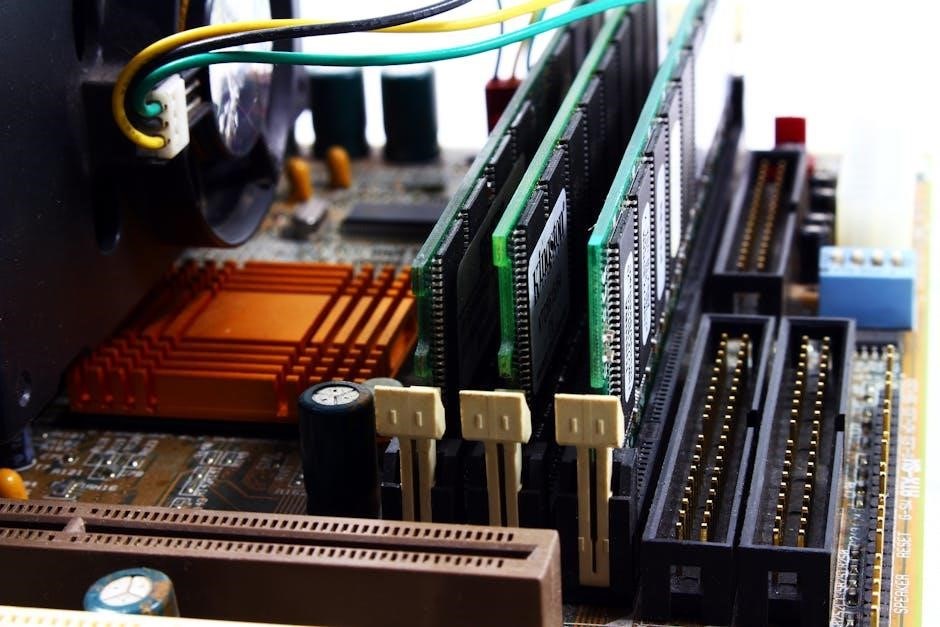This guide provides comprehensive information on trailer wiring, covering connectors, diagrams, and step-by-step instructions. Learn about different connector types like 4-way, 5-way, 6-way, and 7-way. Discover how to properly wire your trailer for safe and efficient operation.
Trailer wiring is essential for safe towing, ensuring that your trailer’s lights and brakes function correctly. This guide provides a comprehensive overview of trailer wiring, covering everything from understanding different types of connectors to troubleshooting common issues. Proper trailer wiring ensures that your trailer’s lights, including brake lights, turn signals, and running lights, are synchronized with your tow vehicle. This synchronization is crucial for signaling your intentions to other drivers, enhancing safety on the road. A well-maintained trailer wiring system also minimizes the risk of electrical shorts and overloads, preventing potential damage to your vehicle and trailer.
Understanding the basics of trailer wiring is the first step towards ensuring a safe and reliable towing experience. This introduction will walk you through the fundamentals, setting the stage for more detailed explanations in subsequent sections. By mastering these principles, you can confidently tackle trailer wiring projects and maintain your system effectively.
Understanding Trailer Wiring Connectors
Trailer wiring connectors are crucial for establishing a secure electrical connection between your tow vehicle and trailer. These connectors come in various types, each designed to accommodate different functions and wiring configurations. Understanding the purpose of each pin within these connectors is essential for proper wiring and troubleshooting. The most common types include 4-way flat, 5-way flat, 6-way round, and 7-way RV blade connectors.
Each type of connector serves specific purposes, such as providing connections for tail lights, brake lights, turn signals, and auxiliary power. The number of pins on a connector corresponds to the number of functions it can support. For example, a 4-way connector typically handles basic lighting, while a 7-way connector can also accommodate electric brakes and backup lights. Knowing which connector type is appropriate for your trailer’s needs is the first step in ensuring a safe and functional wiring system.

Types of Trailer Wiring Connectors
Various trailer wiring connectors exist, each designed for specific functions. Common types include 4-way flat, 5-way flat, 6-way round, and 7-way RV blade connectors. Understanding their differences ensures proper connections.
4-Way Flat Connector
The 4-way flat connector is the most basic and commonly used connector for light-duty trailers. It provides connections for essential lighting functions, including ground, tail lights, left turn signal/brake light, and right turn signal/brake light. These connectors are simple to install and are typically found on small utility trailers, boat trailers, and other trailers that primarily require basic lighting.
The 4-way flat connector is very popular due to its simplicity, compact size, and affordability. They are also called 4-pin connectors.
While the 4-way connector is adequate for basic lighting, it does not support additional functions such as electric brakes or auxiliary power. For trailers requiring these features, a connector with more pins is necessary.
5-Way Flat Connector
The 5-way flat connector builds upon the functionality of the 4-way by adding a fifth wire, typically used for electric trailer brakes. This connector is commonly found on trailers equipped with electric brakes, providing the necessary connection for brake activation. The 5-way flat connector includes the same connections as the 4-way (ground, tail lights, left turn/brake, right turn/brake) plus the electric brake wire.
This extra wire allows the tow vehicle to control the trailer’s brakes, enhancing safety and control, especially when hauling heavier loads. Its main use is to enhance the trailer’s brake system.
While not as common as the 4-way or 7-way connectors, the 5-way serves a specific purpose for trailers with electric brakes, offering a balance between simplicity and added functionality.
6-Way Round Connector

The 6-way round connector is a less common but useful option, often found on older trailers or specialized equipment. It provides connections for essential lighting functions, electric brakes, and an auxiliary power wire. The typical functions supported by a 6-way round connector include ground, tail lights, left turn signal, right turn signal, electric brakes, and a 12V power supply.
The 12V power supply can be used to charge a trailer battery or power interior lights. While offering more functionality than a 4-way or 5-way, the 6-way round connector is gradually being replaced by the more versatile 7-way RV blade connector.
However, understanding its pin configuration and wiring is still important when dealing with older trailer setups.
7-Way RV Blade Connector
The 7-way RV blade connector is a standard in modern trailering, particularly for recreational vehicles and trailers with electric brakes. This connector incorporates all the functions of the 4-way, 5-way, and 6-way connectors, adding extra capabilities.
These enhanced capabilities include a dedicated reverse light circuit and an auxiliary power wire for charging trailer batteries. A typical 7-way RV blade connector includes pins for ground, tail lights, left turn signal, right turn signal, electric brakes, reverse lights, and a 12V auxiliary power supply.
Its robust design and comprehensive functionality make the 7-way RV blade connector the preferred choice for towing larger trailers, travel trailers, and campers.

Trailer Wiring Diagrams
Trailer wiring diagrams are essential for safe and correct connections. They provide visual representations of the wiring layout, color-coding, and component locations. Understanding these diagrams is crucial for troubleshooting and maintenance.
Importance of Trailer Wiring Diagrams
Trailer wiring diagrams are indispensable for anyone working with trailer electrical systems. They serve as roadmaps, clearly illustrating how various components are connected. Without a diagram, tracing wires and identifying their functions becomes a daunting task, increasing the risk of errors and potential damage. These diagrams are crucial for ensuring that all lights, brakes, and other electrical functions operate correctly and safely.
Moreover, wiring diagrams are essential for troubleshooting electrical issues. When a problem arises, such as a malfunctioning light or brake, a diagram allows you to systematically trace the circuit and pinpoint the source of the fault. By following the diagram, you can quickly identify any breaks, shorts, or incorrect connections. Accurate trailer wiring diagrams are invaluable resources for both novice and experienced trailer owners, promoting safety and preventing costly repairs. Using a diagram is always the safest and easiest way to handle trailer wiring.
Color-Coding Standards in Wiring Diagrams
Understanding color-coding is paramount when interpreting trailer wiring diagrams. Standardized color schemes ensure consistency and prevent confusion during installation and repairs. Typically, brown wires indicate running lights, yellow signifies left turn signals and stop lights, while green denotes right turn signals and stop lights. White wires are universally used for ground connections, providing a crucial safety measure.
Blue wires often represent electric brakes, and red wires may be used for auxiliary power or other functions. Always consult the specific wiring diagram for your trailer, as slight variations can occur between manufacturers. By adhering to these color-coding standards, you can confidently navigate trailer wiring systems, ensuring proper connections and minimizing the risk of electrical malfunctions. Remember, verifying wire functions with a circuit tester is always a good practice, regardless of color.
Finding Wiring Diagrams for Specific Trailers
Locating the correct wiring diagram is essential for any trailer wiring project. Start by checking the trailer’s documentation, often included with the original purchase. Many manufacturers also provide online resources, including downloadable wiring diagrams specific to their models. Search the manufacturer’s website using the trailer’s make, model, and year.
Online forums and communities dedicated to trailers and RVs can also be valuable sources. Experienced users often share diagrams or provide guidance on where to find them. Websites specializing in trailer parts and accessories may also offer wiring diagrams as a resource for their customers. Always verify the diagram’s accuracy before using it, comparing it to the actual wiring on your trailer. A correct diagram ensures safe and effective wiring.

Wiring a Trailer: Step-by-Step Guide
This section provides a step-by-step guide to wiring a trailer, including necessary tools, best practices for connecting wires, and proper grounding techniques. Follow these instructions for a safe and functional trailer wiring system.
Tools and Materials Needed
Before commencing any trailer wiring project, gathering the necessary tools and materials is crucial for efficiency and safety. Essential tools include a wire stripper, crimping tool, circuit tester, and multimeter. A reliable set of screwdrivers, pliers, and electrical tape are also indispensable.
For wiring, you’ll need an appropriate length of trailer wire, typically color-coded for easy identification. Acquire the correct type of trailer wiring connector (4-way, 5-way, 6-way, or 7-way) that matches your vehicle and trailer. Additionally, consider purchasing wire connectors, zip ties, and a grounding screw.
Safety glasses and gloves are essential personal protective equipment. Having a wiring diagram specific to your trailer model is highly recommended. Finally, ensure you have a power drill and drill bits for mounting connectors and securing wiring.
Connecting Wires: Best Practices
When connecting trailer wires, following best practices ensures a secure and reliable electrical connection. Always disconnect the vehicle’s battery before starting any wiring work to prevent short circuits. Use a wire stripper to remove insulation without damaging the wire strands.
Twist the exposed wire strands together tightly before making a connection. Use high-quality crimp connectors to join wires securely, ensuring a strong mechanical and electrical bond. After crimping, gently tug on the connection to verify its strength.
If soldering wires, apply heat evenly and use rosin-core solder for a clean connection. Insulate all connections thoroughly with electrical tape or heat shrink tubing to prevent corrosion and short circuits. Route wires neatly and securely, avoiding sharp edges and moving parts. Use zip ties to bundle and support the wiring harness.
Grounding the Trailer Wiring
Proper grounding is crucial for a safe and functional trailer wiring system. The ground wire provides a return path for electrical current, preventing shorts and ensuring lights and brakes function correctly. Always connect the ground wire to a clean, rust-free metal surface on the trailer frame.
Use a self-tapping screw or bolt to create a secure connection. Scrape away any paint or corrosion to ensure good metal-to-metal contact. Apply a dab of dielectric grease to the connection to prevent future corrosion. The ground wire should be the same gauge as the other wires in the harness.
Avoid grounding to the trailer’s body panels, as they may not provide a reliable electrical path. Regularly inspect the ground connection for looseness or corrosion. A poor ground can cause intermittent lighting problems and even damage to electrical components.

Troubleshooting Trailer Wiring Issues
Identify and resolve common trailer wiring problems. Use a circuit tester to diagnose issues. Repair damaged wires and connectors effectively. Ensure your trailer lights and brakes function properly for safe towing practices and avoiding accidents.

Identifying Common Problems
Identifying common problems in trailer wiring is crucial for ensuring safe and reliable towing. One frequent issue is malfunctioning lights, where brake lights, turn signals, or running lights fail to operate correctly. This can stem from corroded connectors, damaged wires, or faulty bulbs. Another prevalent problem involves grounding issues, leading to intermittent or non-functional lights.
Short circuits can also occur, often caused by frayed wires contacting the trailer frame. Additionally, mismatched or improperly connected wiring can result in electrical malfunctions. Regularly inspecting wiring harnesses for wear and tear, loose connections, and corrosion is essential for preventing these common trailer wiring problems.
Recognizing these issues early can save time and prevent potential hazards on the road. Addressing these problems proactively ensures that the trailer’s electrical system functions as intended.
Using a Circuit Tester
A circuit tester is an invaluable tool for diagnosing electrical issues in trailer wiring. This simple device helps determine if a circuit is receiving power. To use a circuit tester, first, connect the tester’s ground clip to a known good ground on the trailer or vehicle. Then, probe the various points in the wiring system you want to test, such as the connector pins or individual wires.
If the circuit is live, the tester’s light will illuminate, indicating that power is present. If the light does not turn on, it suggests a break in the circuit, a blown fuse, or a grounding problem. Use the circuit tester to systematically trace the wiring to identify the source of the issue.
Always consult the trailer wiring diagram to understand the expected voltage at each point. This methodical approach can quickly pinpoint the location of electrical faults, making repairs more efficient and accurate.
Repairing Damaged Wires and Connectors
Damaged wires and connectors are common culprits behind trailer wiring problems. Begin by inspecting the wiring harness for any signs of wear, such as frayed insulation, corrosion, or broken strands. For minor damage, electrical tape can provide a temporary fix, but a more permanent solution involves replacing the damaged section.
When splicing wires, use quality connectors like butt splices or solder and heat shrink tubing to ensure a secure and weatherproof connection. Corroded connectors should be cleaned with a wire brush or replaced entirely. To replace a connector, carefully disconnect the old one, noting the wire positions.
Then, strip the wires and attach them to the new connector, matching the original configuration. After completing the repair, test the circuit with a circuit tester to verify proper function. Regular inspections and timely repairs can prevent more significant wiring issues down the road, ensuring safety and reliability.

Trailer Wiring Safety Tips
Ensure proper connections to prevent malfunctions. Avoid shorts and overloads by using the correct fuses. Regularly inspect your trailer wiring for damage and wear. Proper maintenance is crucial for safety.
Importance of Proper Connections
Proper trailer wiring connections are paramount for safe towing. A secure connection ensures that all trailer lights—brake lights, turn signals, and running lights—function correctly, alerting other drivers to your intentions. Faulty wiring can lead to unpredictable behavior, increasing the risk of accidents and legal issues. When signals are not properly sent from the towing vehicle to the trailer.
A loose or incorrect connection can also damage the electrical systems of both the towing vehicle and the trailer, leading to costly repairs. Furthermore, ensuring a solid ground connection is vital to prevent electrical shorts and corrosion, which can compromise the entire wiring system’s integrity. Always double-check all connections.

Avoiding Shorts and Overloads
Preventing electrical shorts and overloads in trailer wiring is crucial for safety and system longevity. Shorts occur when a bare wire contacts a metal surface, causing a surge of electricity that can melt wires and start fires. To avoid this, always use properly insulated wires and ensure they are securely fastened and protected from abrasion. Regularly inspect wiring for any signs of damage or wear, and replace worn sections immediately.
Overloads happen when the circuit exceeds its maximum amperage capacity, potentially damaging the wiring and connected devices. Using the correct fuse rating is essential to prevent overloads. Never use a fuse with a higher amperage than specified, as this bypasses the safety mechanism. Always consult your trailer’s wiring diagram.

Regular Maintenance and Inspection
Regular maintenance and inspection of your trailer wiring are essential for ensuring safety and preventing costly repairs. Before each trip, visually inspect all wiring for signs of damage, such as cracks, frayed insulation, or loose connections. Pay close attention to areas where wires are exposed or subject to movement. Check the trailer connectors for corrosion or damage, cleaning or replacing them as needed.
Test all lights, including brake lights, turn signals, and running lights, to confirm they are functioning correctly. Use a circuit tester to verify proper voltage and grounding. Periodically tighten all connections, as vibrations can cause them to loosen over time; Applying dielectric grease to connections helps prevent corrosion and ensures a good electrical contact, extending the lifespan of your wiring system.
